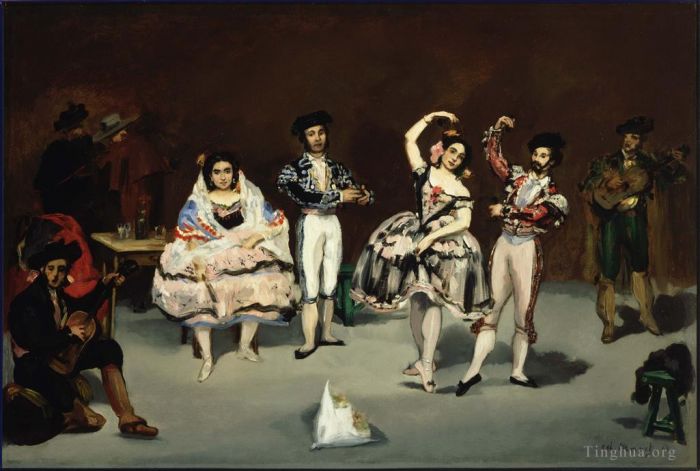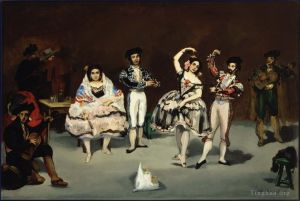The spanish ballet
Edouard Manet
- Price: Price on Request
- Art Type: Oil Painting
- Size:
- English Comments: 0
- International Comments: 0
- Creating Date:
- Introduction and Works of Edouard Manet >>
Work Overview
- The spanish ballet
Edouard Manet
Date: 1862; Paris, France *
Style: Realism
Genre: genre painting
Media: oil, canvas
Location: Philips Collection, Washington, DC, US
Manet's "espagnolisme" reached fever pitch in the 1860s, any subject was good so long as it was Spanish. When a Spanish ballet troupe came to Paris, Manet painted the troupe as a whole, some dancers raising their arms in a bashful adumbration of dance.
Jaime (Jaques) Bosch was a Catalan composer and guitar player who settled in Paris in 1852. He gave numerous concerts and performed in the private homes of a music-loving circle for which Manet seems to have orginized his engagements. He played indeed at Manet’s home, perhaps accomponied at the piano by madame Manet. Madame Paul Meurice wrote to Beaudelaire: Madame Manet played like an angel. Monsieur Bosch scratched his guitar like a treasure.
Bosch posed for his great friend, the painter Edouard Manet, for the figure of the two Mexican generals that appear in his painting The Execution of the Emperor Maximilian of Mexico. Furthermore, the painter had illustrated the title page of one of his scores for the guitar in 1862: Plainte Moresque, dedicated ‘ à Mr Edouard Manet ’
With astonishing freedom, unsurpassed depth of feeling, and an unusually happy choice of colors, Manet has painted the Spanish company who were dancing at that time at the Hippodrome in Paris. Among them are Lola de Valence, seated, and, standing, the famous dancer Mariano Camprubi.
For this painting Manet made a preliminary drawing heightened with water-color and gouache. After painting the company, he asked Lola de Valence to pose for him several times. Jacques de Bietz described Manet at this time: "This rebellious spirit, who deliberately defied all conventions and despised all the tricks that win prestige in the artificial world of high society, was no brute, no coarse stable-boy, no ruffian. Far from it. It was impossible to deny that this new artistic genius, from whose alleged noxious and sordid realism society was turning in disgust, was, as all who had met him could testify, a perfect gentleman, well-bred and distinguished, amiable and courteous, and, what is more, most elegantly dressed."
With astonishing freedom, unsurpassed depth of feeling, and an unusually happy choice of colors, Manet has painted die Spanish company who were dancing at that time at the Hippodrome in Paris. Among them are Lola de Valence, seated, and, standing, the famous dancer Mariano Camprubi.
For this painting Manet made a preliminary drawing heightened with water-color and gouache. After painting the company, he asked Lola de Valence to pose for him several times. Jacques de Bietz described Manet at this time: "This rebellious spirit, who deliberately defied all conventions and despised all the tricks that win prestige in the artificial world of high society, was no brute, no coarse stable-boy, no ruffian. Far from it. It was impossible to deny that this new artistic genius, from whose alleged noxious and sordid realism society was turning in disgust, was, as all who had met him could testify, a perfect gentleman, well-bred and distinguished, amiable and courteous, and, what is more, most elegantly dressed."
Manet exhibited this work for the first time at the Galerie Martinet, boulevard des Italiens, in February and March 1863, together with Music in the Tuileries, Lola de Valence, Street Singer, and Old Musician.
- Copyright Statement:
All the reproduction of any forms about this work unauthorized by Singing Palette including images, texts and so on will be deemed to be violating the Copyright Laws.
To cite this webpage, please link back here.
- >> English Comments
- >> Chinese Comments
- >> French Comments
- >> German Comments
- >>Report
- Basket of Fruits
- The monk at prayer
- At Father Lathuille
- The Luncheon on the Grass (The Bath)
- The Grand Canal Venice
- Portrait of Emile Zola
- Portrait of Lina Campineanu
- Young Man in the Costume of a Majo
- The Bullfight
- Bench in autumn
- Victorine Meurent in the costume of an Espada
- Portrait of Zacharie Astruc
- Carnations and clematis in a crystal vase
- A boy with a pitcher
- Madame Brunet
- A matador
- On the Beach at Boulogne
- Reading Mme Manet and Leon
- Peaches
- The Kearsarge at Boulogne (Fishing boat coming in before the wind)
- Interior at Arcachon
- The ragpicker
- Woman in furs
- The model
- Madame Manet on a Blue Sofa
- Monet in his Studio Boat (Claude Monet Painting on His Boat-Studio in Argenteuil)
- Guitar and Hat
- The House at Rueil
- The Suicide
- Branch of White Peonies and Pruning Shears
- Jetty at Boulogne
- Portrait of Faure as Hamlet
- The Railway (Gare Saint-Lazare)
- Marguerite de Conflans Wearing Hood
- Theodore Duret
- Steamboat Leaving Boulogne
- Portrait of Gilbert Marcellin Desboutin
- Still Life Fruits on a Table
- The garden around Manet house
- Corner of a Café-Concert
- Boy with Dog
- Portrait of Mademoiselle Claus
- Young woman with a pink shoe
- Le Bon Bock A Good Glass of Beer
- Boy Blowing Bubbles
- Berthe Morisot with a Bouquet of Violets
- Portrait of Monsieur Brun
- Portrait of Emilie Ambre in the role of Carmen
- Effect of Snow at Petit Montrouge
- Vase of White Lilacs and Roses
- View of the 1867 Exposition Universelle
- Study of trees
- Moss Roses in a Vase
- Angelina
- Roses in a Champagne Glass
- Spring Study of Jeanne Demarsy
- The barque of Dante Copy after Delacroix
- The Street Singer
- Singer at a Cafe Concert
- Baudelaires Mistress Reclining Study of Jeanne Duval
- The Lemon
- Repose Study of
- A Game of Croquet
- Polichinelle
- Masked Ball at the Opera
- Bundle of Asparagus
- The Departure Of The Folkestone Boat
- The spanish ballet
- Argenteuil
- Plum
- At the Cafe
- Bench
- Gypsy with a Cigarette
- Rose and tulip
- Vase of Peonies on a Small Pedestal
- The Dead Christ with Angels
- Stephane Mallarme
- Nana
- Music in the Tuileries
- Christ with Angels
- Madame Manet in conservatory
- Swallows
- The Luncheon in the Studio
- Flowers in a Crystal Vase
- Madame Manet at the Piano
- Rochefort Escape
- The philosopher
- Still Life with Brioche
- Lola de Valence
- Bull fighting scene
- Portrait of Eva Gonzales
- Bouquet of flowers
- Eva Gonzales
- The Spanish Singer The Guitar Player
- Portrait of Mademoiselle Isabelle Lemonnier
- The Blonde with Bare Breasts
- The Waitress
- Woman with umbrella
- Young woman in the garden
- A Corner of the Garden in Rueil
- Madame Manet at Bellevue
- The Rest portrait of
- Woman Reading
- Bathers on the Seine
- Two Roses on a Tablecloth
- Le Chemin De Fer The Railroad
- The burial
- Execution of the Emperor Maximilian
- Embarkation after Folkestone
- Portrait of Henry Bernstein as a Child
- Head of a Dog
- The head of Christ
- Mother in the Garden at Bellevue
- Autumn Study of Mery Laurent
- The Races in the Bois de Boulogne
- Still life with melon and peaches
- Woman Before a Mirror
- Jesus Mocked by the Soldiers
- Flowers In A Crystal Vase flower Impressionism Edouard Manet
- The Port of Bordeaux
- A brioche
- Rue Mosnier decorated with Flags
- The Banks of the Seine at Argenteuil
- Lilac in a glass
- Woman Pouring Water Study of Suzanne Leenhoff
- The Monet family in their garden at Argenteuil
- View of Holland
- Portrait of Antonin Proust Realism Impressionism Edouard Manet
- Boating
- A King Charles Spanie
- Peonies in a vase
- The Horsewoman
- M and Mme Auguste Manet
- The conservatory
- Woman in a Tub
- A young man peeling a pear
- The Jetty at Boulogne
- Interior of a Cafe
- The ham
- On The Beach
- Pertuiset Lion Hunter
- The grand canal of Venice
- Oysters
- The Execution of the Emperor Maximilian of Mexico
- In the garden
- Portrait of Antonin Proust
- Victorine Meurent
- Young woman with a book
- Tarring the Boat
- Young woman in a round hat
- The Races at Longchamp
- The Milliner
- At the races
- The absinthe drinker
- Olympia
- Seascape at Berck Fishing Boats and Fishermen
- The old musician
- The Balcony
- Fishing
- Madame Auguste Manet
- The Boy with Cherries
- The Fifer
- Women at the Races
- Portrait of Suzanne Manet
- Surprised Nymph
- Portrait of Monsieur Tillet
- Almonds currants and peaches
- The stroll
- Young Woman in Oriental Garb
- Battle of Kearsage and Alabama
- The road menders Rue de Berne
- Woman with a Parrot
- Boy with a sword
- Eel and Red Mullet
- Woman with Fans (The Lady with Fans or Portrait of Nina de Callias)
- The Café-Concert (At the Café or The Bock Drinkers)
- The salmon
- Seascape at Arcachon
- The Garden at Bellevue
- The dead toreador
- Young Woman Reclining in Spanish Costume
- Young woman among the flowers
- Woman fastening her garter
- A Bar at the Folies-Bergère
- Bouquet Of Violets still life Impressionism Edouard Manet
- The Port of Bordeaux 2
- Head Of A Man
- Young woman in a negligee
- Portrait Of Mme Jules Guillemet
- On the Bench
- The Barricade Civil War









 Singing Palette
Singing Palette